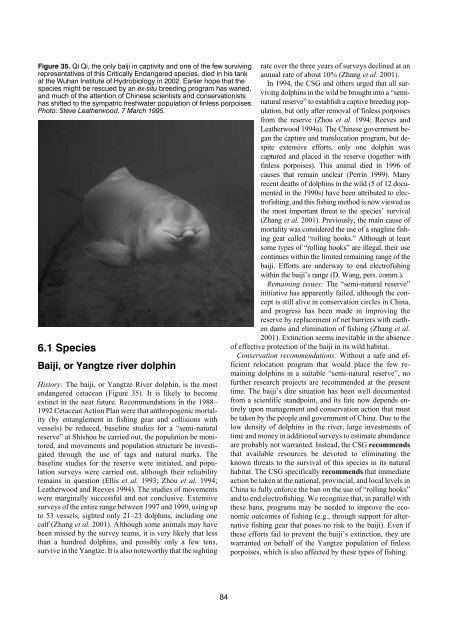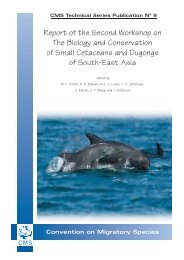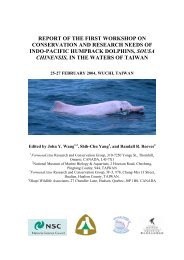Dolphins, Whales and Porpoises: 2002-2010 Conservation - IUCN
Dolphins, Whales and Porpoises: 2002-2010 Conservation - IUCN
Dolphins, Whales and Porpoises: 2002-2010 Conservation - IUCN
Create successful ePaper yourself
Turn your PDF publications into a flip-book with our unique Google optimized e-Paper software.
Figure 35. Qi Qi, the only baiji in captivity <strong>and</strong> one of the few surviving<br />
representatives of this Critically Endangered species, died in his tank<br />
at the Wuhan Institute of Hydrobiology in <strong>2002</strong>. Earlier hope that the<br />
species might be rescued by an ex-situ breeding program has waned,<br />
<strong>and</strong> much of the attention of Chinese scientists <strong>and</strong> conservationists<br />
has shifted to the sympatric freshwater population of finless porpoises.<br />
Photo: Steve Leatherwood, 7 March 1995.<br />
6.1 Species<br />
Baiji, or Yangtze river dolphin<br />
History: The baiji, or Yangtze River dolphin, is the most<br />
endangered cetacean (Figure 35). It is likely to become<br />
extinct in the near future. Recommendations in the 1988–<br />
1992 Cetacean Action Plan were that anthropogenic mortality<br />
(by entanglement in fishing gear <strong>and</strong> collisions with<br />
vessels) be reduced, baseline studies for a “semi-natural<br />
reserve” at Shishou be carried out, the population be monitored,<br />
<strong>and</strong> movements <strong>and</strong> population structure be investigated<br />
through the use of tags <strong>and</strong> natural marks. The<br />
baseline studies for the reserve were initiated, <strong>and</strong> population<br />
surveys were carried out, although their reliability<br />
remains in question (Ellis et al. 1993; Zhou et al. 1994;<br />
Leatherwood <strong>and</strong> Reeves 1994). The studies of movements<br />
were marginally successful <strong>and</strong> not conclusive. Extensive<br />
surveys of the entire range between 1997 <strong>and</strong> 1999, using up<br />
to 53 vessels, sighted only 21–23 dolphins, including one<br />
calf (Zhang et al. 2001). Although some animals may have<br />
been missed by the survey teams, it is very likely that less<br />
than a hundred dolphins, <strong>and</strong> possibly only a few tens,<br />
survive in the Yangtze. It is also noteworthy that the sighting<br />
rate over the three years of surveys declined at an<br />
annual rate of about 10% (Zhang et al. 2001).<br />
In 1994, the CSG <strong>and</strong> others urged that all surviving<br />
dolphins in the wild be brought into a “seminatural<br />
reserve” to establish a captive breeding population,<br />
but only after removal of finless porpoises<br />
from the reserve (Zhou et al. 1994; Reeves <strong>and</strong><br />
Leatherwood 1994a). The Chinese government began<br />
the capture <strong>and</strong> translocation program, but despite<br />
extensive efforts, only one dolphin was<br />
captured <strong>and</strong> placed in the reserve (together with<br />
finless porpoises). This animal died in 1996 of<br />
causes that remain unclear (Perrin 1999). Many<br />
recent deaths of dolphins in the wild (5 of 12 documented<br />
in the 1990s) have been attributed to electrofishing,<br />
<strong>and</strong> this fishing method is now viewed as<br />
the most important threat to the species’ survival<br />
(Zhang et al. 2001). Previously, the main cause of<br />
mortality was considered the use of a snagline fishing<br />
gear called “rolling hooks.” Although at least<br />
some types of “rolling hooks” are illegal, their use<br />
continues within the limited remaining range of the<br />
baiji. Efforts are underway to end electrofishing<br />
within the baiji’s range (D. Wang, pers. comm.).<br />
Remaining issues: The “semi-natural reserve”<br />
initiative has apparently failed, although the concept<br />
is still alive in conservation circles in China,<br />
<strong>and</strong> progress has been made in improving the<br />
reserve by replacement of net barriers with earthen<br />
dams <strong>and</strong> elimination of fishing (Zhang et al.<br />
2001). Extinction seems inevitable in the absence<br />
of effective protection of the baiji in its wild habitat.<br />
<strong>Conservation</strong> recommendations: Without a safe <strong>and</strong> efficient<br />
relocation program that would place the few remaining<br />
dolphins in a suitable “semi-natural reserve”, no<br />
further research projects are recommended at the present<br />
time. The baiji’s dire situation has been well documented<br />
from a scientific st<strong>and</strong>point, <strong>and</strong> its fate now depends entirely<br />
upon management <strong>and</strong> conservation action that must<br />
be taken by the people <strong>and</strong> government of China. Due to the<br />
low density of dolphins in the river, large investments of<br />
time <strong>and</strong> money in additional surveys to estimate abundance<br />
are probably not warranted. Instead, the CSG recommends<br />
that available resources be devoted to eliminating the<br />
known threats to the survival of this species in its natural<br />
habitat. The CSG specifically recommends that immediate<br />
action be taken at the national, provincial, <strong>and</strong> local levels in<br />
China to fully enforce the ban on the use of “rolling hooks”<br />
<strong>and</strong> to end electrofishing. We recognize that, in parallel with<br />
these bans, programs may be needed to improve the economic<br />
outcomes of fishing (e.g., through support for alternative<br />
fishing gear that poses no risk to the baiji). Even if<br />
these efforts fail to prevent the baiji’s extinction, they are<br />
warranted on behalf of the Yangtze population of finless<br />
porpoises, which is also affected by these types of fishing.<br />
84





